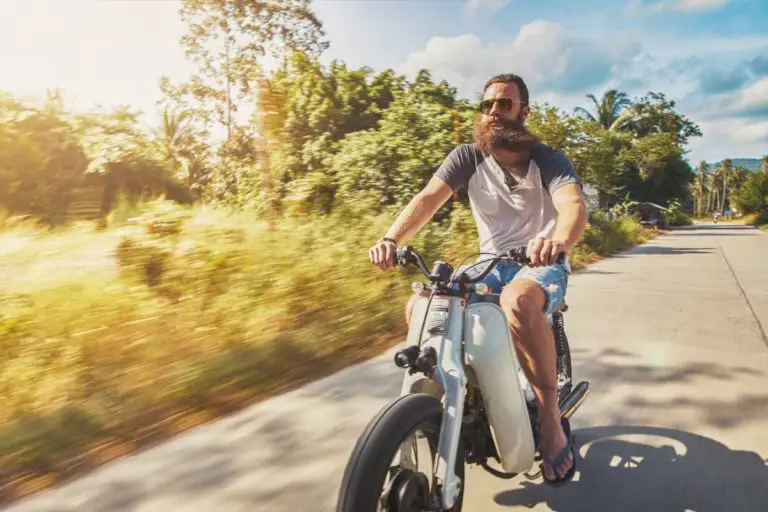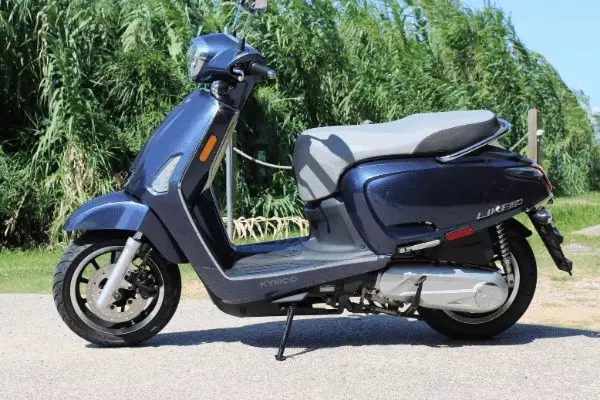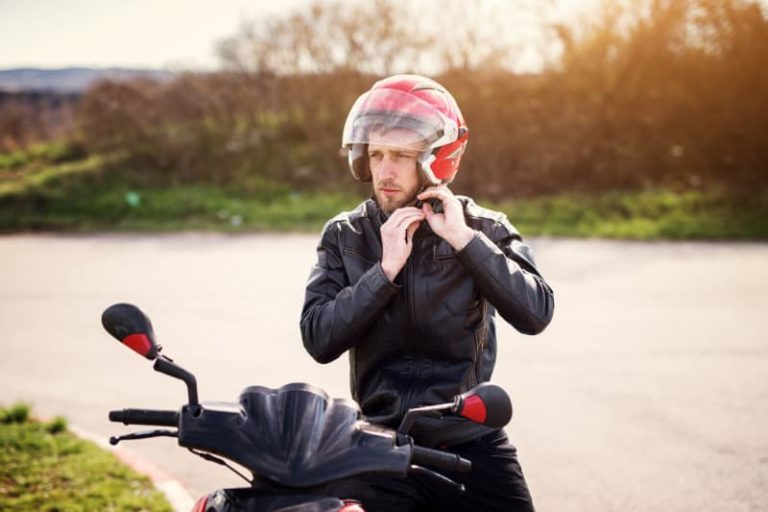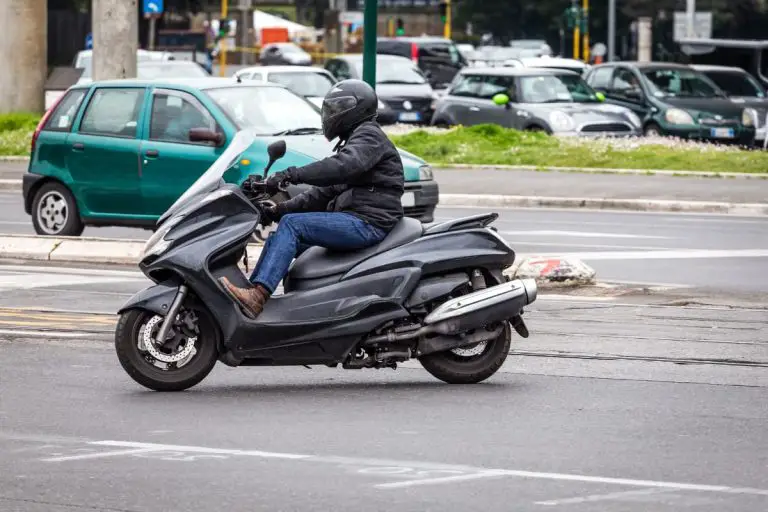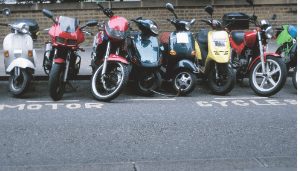Choosing a scooter or moped to buy can be a ton of fun, but it is easy to find yourself overwhelmed, too. There is a reason there are a variety of scooters to choose from, after all. While picking out the color might be obvious to you, let us walk through some questions to ask yourself to buy a scooter that matches your needs.
To be able to share good advice, I consulted 2 local scooter dealers for this post. You’ll find their guidance scattered throughout this post. Also know that they both also do scooter mechanic work (on more than just the brands they sell).
You’ll find an overview of what the major components to know when shopping for a scooter in this post, but if you are already knowledgeable in that space, jump on into the SPREADSHEET TO COMPARE section of the Table of Contents.
Table of Contents
If you already know about the different features of scooters and what they mean, you can always skip ahead to the spreadsheet here.
What Size Engine Should You Buy?
Both of the scooter dealers I consulted with said that you start here.
Engine Size is the most important factor when choosing a scooter!
Your engine needs are one of the biggest considerations in choosing a scooter. Notice I said needs, not wants. You want to be sure that the engine size matches the roads you plan to ride on. While there is more to the price of a scooter than the engine size, it is a significant driving factor for their prices.
Consider Where You Will Ride Your Scooter to Choose
The size of the engine is described in cubic centimeters of displacement. From here on, we’ll call those cc, but it is a measurement of the fuel and air mixture that the motor uses to move the scooter forward.
The bottom line is that the higher the number, the faster the scooter will be able to go. This becomes important when you think about where you plan to ride.
Keep this in the back of your mind, but your speed is the biggest factor that YOU CAN CONTROL in regards to avoiding accidents on your scooter as long as your scooter has the power to do so. You need to keep pace with the flow of traffic even it is just to get out of the way & find another route that fits your scooter capabilities!
Hello, drivers that text…
Engine Size vs Road Speed Limits
Are you hoping to scoot around a college campus with a speed limit at or below 30 miles per hour (mph) on mostly flat terrain? Then you can stick with a 50cc as your minimum needs.
If you have a lot of hills to contend with, even with the lower speed limit, you’ll want to go with a larger engine. Check out this guide I put together on the top speeds you can expect for scooters in this range.
Are the roads you are planning to travel on in the 45mph range? You will want to get a 125-175cc scooter option. Again, the more hills in your area, the more you’ll benefit from being in the higher engine size of the range.
Here’s a guide for the top speeds to expect for scooters in the 125cc range.
If you hope to get on a freeway, you’ll be looking for 250+cc. Check out the best scooters for highway riding here.
Those are just guidelines. There are 50cc scooters like the Vespa Primavera 50 that can go 40mph, and I ride a Buddy Kick 125cc that I have seen over 60 mph.
That said, the engines are not designed to maintain the higher end of their speed for extended periods. While I can drive 60 mph, you will not find me on a freeway.
In summary, if you are in the camp that bigger is better, then go for it.
However, if the scooter you choose has far too much power that makes you uncomfortable, then it won’t be nearly as fun to ride. It’s a careful balance, but ultimately, choosing the size of the engine is a personal preference after you consider your needs based on your area.
Check out the video below to learn from my giant mistake when I was shopping to buy a scooter.
2-stroke vs 4-stroke
A 2-stroke engine means the cycle is completed in 2 strokes of the piston, and the 4-stroke does this in 4 strokes. It sounds like the 4-stroke does double the work, but it’s really the 2-stroke that has to work a bit harder.
A couple of simplified thoughts for the fellow scooter newbie:
- 2-strokes will have more power when you’re accelerating and feel more powerful
- 2-strokes are cheaper
- 4-strokes are more fuel-efficient
The larger the engine size, the less of an option you get. At 150cc, you’re going to get a 4-stroke, so you don’t have to overthink this unless you’re looking more in the moped, 50cc size range when you’re ready to buy a scooter.
More on the 2-stroke vs 4-stroke pros and cons here
Electronic vs Carbureted Fuel Injection
A scooter’s motor passes a mixture of air and fuel to make it go. A carburetor does this in a more manual fashion. An electronic fuel injection engine does this in a more optimal way through sensors and such.
A couple of thoughts on this to help you decide:
- Carburated fuel injection is simpler to work on and cheaper.
- Electronic fuel injection usually means less work on a motor in general. The air and fuel mixture is more optimal and leads to a longer life.
I’m a fan of electronic fuel injection. They require less of a mechanical aptitude for the times my scooter sits a bit more like the dead of winter.
How Much Should You Spend for a Good Scooter?
Now that you have a sense of what sized engine you need, it is time to talk money as a guide at this point.
Just like other sources of transportation, scooters run from value to high-end models. Have you sat down to look at you are willing to spend on a scooter?
Generally, the bigger the motor, the more expensive the scooter. You’ll need to hone in on the size you’ll need based on the speeds you hope to go as a start to make sure you’re in the range for what you need.
Click here for a full pricing guide of new scooter models along with extra cost considerations.
Here is a price summary by the engine size category to help you see if what you can afford is in line with what you need at this point. Notice that there is a lot of overlap, so don’t count out a scooter in the right engine size for your road needs.
| Engine Size Category | Mid-Range Cost | Lowest Cost | Highest Cost |
| 50cc | $2,000 | $1,599 | $4,099 |
| 100-200cc | $2,900 | $2,099 | $5,699 |
| 200cc+ | $6,600 | $3,995 | $11,049 |
Buy a Scooter That Physically Fits You
Ground to Seat Height
When you’re straddling a seat, you’ll want to be able to touch the ground relatively comfortably when it is off the center stand. Of course, the width of the seat will play into this.
While you can’t quite just depend on the height from the ground to the seat, seat height is still helpful to narrow down your choices.
However, give one a try if a scooter is calling out to you. I did not personally enjoy the fit of the Kymco Like 150i, but a friend of mine that is the same height landed on the Kymco and loves it.
Choosing a comfortable fit will go a long way to making you feel more confident when you’re just starting out.
To illustrate, I am 5’6”, and I was absolutely in love with the look of the Lance Classic Italia 150. Absolutely gorgeous. Then I sat on it, and it was a no go. It was too tall for me to feel comfortable controlling as a newer rider.
Best Scooter Brands
According to the dealers I’ve consulted on this article, you’ll want to avoid the inexpensive Chinese models under $1,000 to prevent learning to be a scooter mechanic pretty quickly.
There is a growing trend that scooter mechanics will decline to work on those models, too. The 2 local dealers here work on all scooter brands BUT NOT those like the Ice Bear, TaoTao & similar brands. Beyond this warning, it boils down to personal preferences and feature sets they offer.
The only thing of note here is that is that Vespa is THE long-standing, classic scooter you’ve likely seen on the big screen. They have body panels are made of metal while others tend to have plastic panels, and they tend to be feature heavy.
Some brands like Genuine and Kymco offer 2-year warranties with unlimited miles which makes me more likely to gamble on a brand I have not heard of.
That’s the tip of the iceberg when you consider that Honda is the best selling globally, and you’ll find great scooters with Yamaha, Suzuki, Lance, and more.
Learn more about the best scooter brands
Scooter Style
There seems to be 2 camps in this space. You like the classic Italian style scooters like the Vespa models or you are into the sporty motorcycle look like the Lance Cabo. Sporty, rugged or classic Italian?
You decide!
Below is a list of the scooters (sometimes called mopeds) based on style. The asterisk * represents electronic fuel injection in case that matters to you.
Classic Italian Mopeds and Scooters
- Lance Cali classic 50/125/200i*
- Lance Havana 50/125/200i*
- Genuine Brio 50i*
- Genuine Urbano 50i*
- Piaggio Typhoon 50/125
- Sym Mio 50
- Kymco Like 50/50i*/150i*
- Genuine Buddy 50/125/170i*
- Honda Metropolitan 50*
- Vespa Primavera 50/150
- Vespa Sprint 50 /150
- Genuine Buddy Kick 125i*
- Lance Italia Classic 150
- Genuine Grand Tourer 150
- Sym Fiddle III 200i*
- Vespa GTS 300*
Sporty, Rugged Mopeds and Scooters
- Genuine Venture 50
- Lance PCH 50
- Lance Cabo 50
- Kymco Agility 50
- Lance Soho 50
- Kymco Super 8 50X/150x
- Genuine Roughhouse 50
- Piaggio Liberty 50
- Honda Ruckus 50
- Honda PCX150*
- Honda ADV150*
- Genuine Hooligan 170i*
- Suzuki Burgman 200/400/650*
- Kymco X-Town 300i*
- Sym Citycom S 300i*
- Piaggio BV 350*
- Piaggio MP3 500*
Comfort & Safety
When you start testing out scooters, pay attention to the seat cushion. I haven’t run across an outright uncomfortable seat, but you’ll want a good one, particularly if you are planning on doing some long rides on your scooter.
Tire size matters. Smaller wheels are better for any quick maneuvering you may find yourself doing in more urban settings. They help your scooter be more agile.
However, the bigger wheels will give you more cushion for bumps or potholes and for long turns at higher speeds. Check out the Piaggio Typhoon versus the BV350. The Typhoon has 12″ tires whereas the BV 350 is better suited for the highway by the engine size and those cushier 16/14″ tires.
ABS brakes are an option on scooters like you see on cars. They are not necessarily commonplace, but you’ll find them.
Essentially ABS brakes will prevent the brakes from locking off if you find yourself in a position to pull those brakes hard & fast to stay out of trouble. It’s a solid safety feature. You’ll find ABS brakes on the Kymco Like 150i and the Vespa models.
Additional Features You Might Appreciate
Be on the lookout for additional features like an extra engine kill switch inside the under-seat storage box. This provides an extra layer of security that makes it a bigger pain to steel. Steering wheel locks and key locks are features that can help here, too.
Some models allow you to charge your phone in the under-seat storage box. Some have locking ‘glove compartments’, and some will have cubbies to toss things in.
Some models will have extra accessories like upgraded racks and windshields already installed like Vespa Touring models and larger scooters like the Kymco AK550 and Suzuki Burgman line-up.
Spreadsheet (best viewed on desktop)
I am all about a good spreadsheet to help me make decisions, and I made one to help me choose my scooter.
My original spreadsheet was just focused on the scooters that I was considering, but since then the spreadsheet has been expanded with the help of the internet plus working with 2 local scooter dealers.
They let me come measure seat heights and such when I am unable to find the information online & answer my newbie questions about the different scooters.
This spreadsheet has all the gas-powered brands and models of scooter that are known to be more reputable along with some details for you to filter on like the engine size, top speed, the MSRP, seat height, and more.
You’ll find model years 2019 and onward, and I check quarterly for new model updates.
I basically used the information to identify my top contenders. Then, I used that information to help me dig for more information about the scooters on the manufacturer’s website and forums such as Reddit.
This really helped narrow down the list, and then I started driving around to dealerships. Sometimes this meant a road trip despite living in a large metro area, but it is important to take the shopping away from a spreadsheet online and interact with the top contenders.
Check out the buttons and knobs and sit on the scooters you’re considering. I was surprised how much I felt like a scooter either did or did not fit by just sitting on it.
If it passed the test at that point, I’d ask to take them for a spin (with my motorcycle endorsement under my belt).
I will say I 100% expected to drive off with a Kymco Like 150i based on my spreadsheet findings, but my experience interacting with the scooters led me to drive off with the Buddy Kick. I will also say my husband wasn’t expecting a scooter at all, and he drove off with a Kymco Like 150i. Go figure.
Time to Scooter Shop!
Scooter shopping is a lot of fun, and none of the dealers I visited felt like the experience you get when you go to a car dealership. It’s much more straight forward, and it is definitely more pleasant!
I’m still chatting with a couple of them to help me with things like this article. They have been a huge help to this newbie!
Just don’t forget to buy that safety gear before zooming off on a scooter! Here is a guide to helmets because I really, really want you to wear one!


